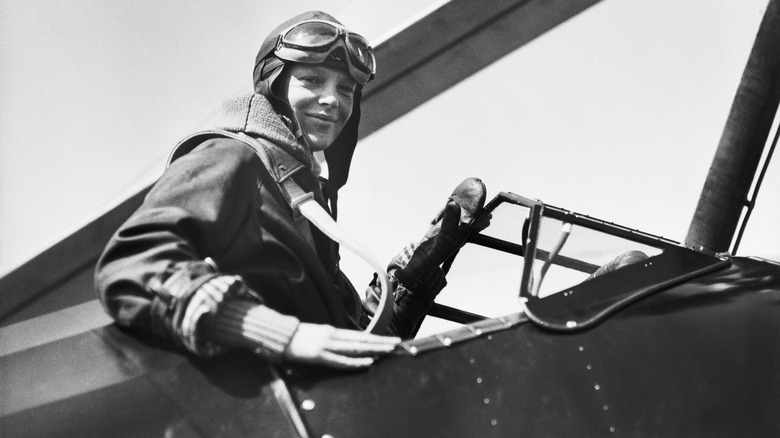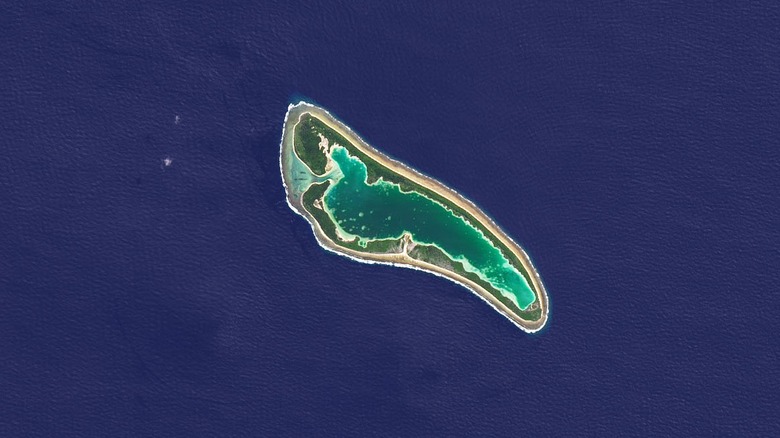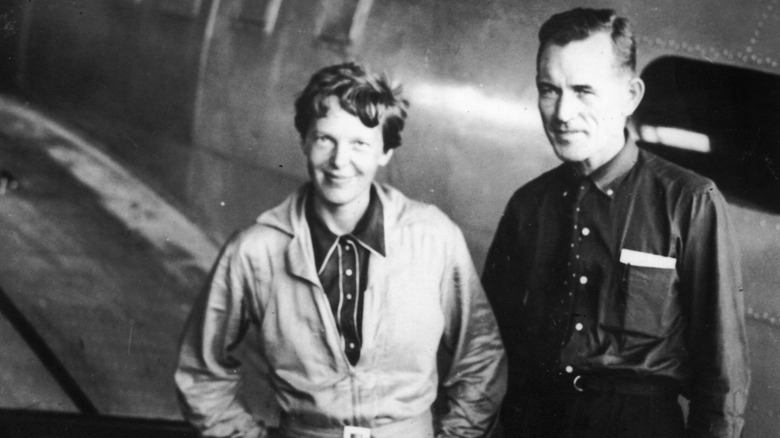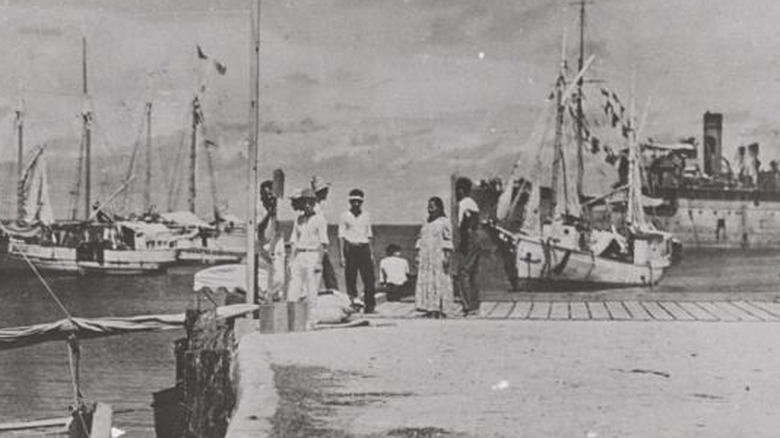Was Amelia Earhart Found? The Biggest Theories On What Happened To Her
Few mysteries have captivated the world more than the disappearance of Amelia Earhart in 1937, the aviator whose star shone as bright in her day as it has through history. As the first woman to traverse the Atlantic on a solo flight, and the first pilot of any gender to fly between the continental U.S. and Hawaii, Earhart represented the seemingly infinite potential felt at the dawn of aviation. Her ambitions knew no bounds, eventually leading her to attempt one of the boldest endeavors in human history.
On June 1, 1937, Earhart and navigator Fred Noonan embarked on a flight around the world, which would have made Earhart the first woman to circumnavigate the Earth by plane. Their chosen route, beginning and ending in Oakland, California, was set to cover 29,000 miles, and its tragic end has come to overshadow the fact that they made it over three-quarters of the way. However, on July 2, while attempting a 2,600-mile leg of the journey between New Guinea and a refueling point on tiny Howland Island, the plane disappeared.
Neither Earhart nor Noonan have been heard from since that day. The U.S. Navy conducted a two-week search for their plane to no avail, and two years later, both were declared legally dead. This unsolved mystery has only grown stranger in years since, as countless explanations have been offered for the death or potential survival of Earhart. Here are the best-known theories, including a new discovery that could change everything.
Amelia Earhart became a castaway
Many theories have suggested that Amelia Earhart was unable to locate Howland Island from the air, and was thus forced to land elsewhere. The island is a small coral atoll barely half a mile in land area, and aircraft of that era — including Earhart's Lockheed Electra 10E — did not yet have radar. The U.S. Coast Guard stationed a patrol boat at Howland Island to help guide her via radio, but in her final transmissions to the ship, Earhart mentioned that she was running low on gas and could not catch sight of her destination.
If Earhart did indeed give up on finding Howland Island and made an emergency landing elsewhere, the most likely point would be Nikumaroro, formerly known as Gardner Island, an uninhabited atoll 350 nautical miles from the intended destination. In 1940, British colonists on Nikumaroro found 13 human bones, which they suspected to be the remains of the lost aviators. The bones were sent to Fiji to be studied but were subsequently lost. However, measurements indicated that the bones belonged to a person of a similar build to Earhart.
The main problem with the Nikumaroro castaway theory is that no definitive evidence of Earhart's Lockheed Electra has been found in the area. Robert Ballard, famed for discovering the wreck of the Titanic, even directed an undersea search around Nikumaroro, but to no avail.
Amelia Earhart and Fred Noonan were secretly spies
Two of the more persistent theories regarding Amelia Earhart's disappearance center on the fraught geopolitical climate of 1937. This was only four years before the attack on Pearl Harbor, and tensions between the U.S. and Japan were already at a dangerous point. Japan was rapidly taking control of the South Pacific; in fact, one reason that Earhart was forced to choose tiny Howland as her pit stop is the fact that Japan had banned Americans from the surrounding islands. Given the intensity of the situation, some have come to believe that Earhart's flight had an ulterior motive: spying on the Japanese territories.
The secret spy theory proposes that U.S. President Franklin Delano Roosevelt wanted intel on the Japanese military's movements through the South Pacific, hoping to expose their activities to the world before a full-scale war could break out. To achieve this end, Earhart and Fred Noonan were instructed to fly over Japanese-controlled islands and take photographs from above. It's been suggested that the Japanese shot down Earhart's plane, either resulting in the aviators' deaths, or their capture and imprisonment by Japanese forces.
The Japanese abducted Amelia Earhart
The idea that Amelia Earhart and Fred Noonan were captured by the Japanese military has been one of the most prominent and consistent theories regarding their disappearance. Some believe in the aforementioned spy theory, but others propose that Earhart was simply forced to make an emergency landing on one of the Japanese-controlled Marshall Islands, where she and Noonan were subsequently taken into custody. One of the main pieces of evidence fueling this theory is a photograph taken on the Marshall Islands that shows a white woman with short hair similar to Earhart's. However, the woman's back is to the camera, making the resemblance shallow. This supposed evidence has since been debunked, as the photograph was found in Japanese archives dated two years prior to Earhart's disappearance.
One version of this theory suggests that Earhart was forced to broadcast propaganda for the Japanese. During WWII, Japan used English-speaking women to broadcast anti-American messages by radio. The women were known only as "Tokyo Rose," and the theory claims that Earhart was one of them. However, Earhart's husband, George Putnam, personally reviewed hours of the Tokyo Rose recordings and did not find any that resembled his wife's voice.
Amelia Earhart assumed a new identity
Perhaps the most outlandish of all the theories surrounding Amelia Earhart's disappearance is the idea that she survived her journey and returned to the U.S., where she lived out the rest of her life under an assumed identity. This theory first appeared in a 1970 book titled "Amelia Earhart Lives," by Joe Klaas. The author partnered with a former Air Force major named Joseph Gervais, who had spent a decade trying to prove that Earhart had been captured by the Japanese, returned to the U.S. after the war, and started a new life in New Jersey.
Klaas and Gervais pointed the finger at Irene Craigmile Bolam, a banker whom they claimed was really Earhart under a new name. Gervais claimed that he had met Bolam at a party for an aviators' organization, and that she told him she was a member of the Ninety-Nines, a women's aviation group famously founded by Earhart herself. However, Gervais was unable to locate Bolam in the group's registry. He noted that she bore a strong resemblance to Earhart, but beyond that, there was little evidence. Bolam sued the book's publisher for libel and settled after court, but in a mysterious turn, when Bolam died in 1982, she instructed that her body should not be fingerprinted, and her death certificate lists no parents.
Her plane was lost beneath the waves
The final, and sadly most probable, theory surmises that Earhart and Noonan did not survive their attempted flight, and that their plane crashed in the South Pacific somewhere between New Guinea and Howland Island. Numerous expeditions have searched the ocean floor for the wreckage of her plane, with a recent development coming in January of 2024. A group of marine archeologists and robotics experts from the American oceanic exploration company Deep Sea Vision announced the potential discovery of Earhart's plane with the aid of sonar systems, which send sound waves into the water and identify objects in the ocean based on how the waves are reflected back.
Deep Sea Visions collected sonar images from 100 miles off the coast of Howland Island that appeared to show the outline of a plane matching the dimensions of a Lockheed Electra. The site was 16,000 feet below the surface of the ocean (that's over 3,000 feet deeper than the wreck of the Titanic), making efforts to verify the discovery extremely challenging. After nearly a year of searching, Deep Sea Visions announced on Instagram that the object they'd discovered was actually a deceptively shaped rock formation, shattering the hopes of millions. With every search, the suspected area of Earhart's disappearance seems to have less and less potential, but as long as the aviator's fate remains a mystery, the effort to find her will persist.
Has the U.S. government been hiding Earhart's secrets?
Throughout the decades since Amelia Earhart and Fred Noonan vanished over the Pacific Ocean, numerous conspiracy theorists have suggested that the United States government may have had a hand in the matter, or at the very least, in covering up the results of the search effort. These theories are typically interwoven with the previously mentioned theories that Earhart and Noonan were spies or were imprisoned by the Japanese government. Documents related to the search for Earhart were declassified and released by both the FBI and the National Archives, but one powerful voice believes there is more to be seen.
On September 26, 2025, President Donald Trump called for full transparency on the Earhart search in a post on Truth Social. While these are not the files many have been hoping for him to release, they certainly have garnered attention due to Earhart's mythical status. According to Trump, "I am ordering my Administration to declassify and release all Government Records related to Amelia Earhart, her final trip, and everything else about her." However, it's not exactly clear what records he is referring to. After the previous releases by the FBI and National Archives, aviation scholar Ric Gillespie told the Associated Press, "There's nothing still classified by the U.S. government on Amelia Earhart." It appears he may be right, as, despite Trump's assurance, no further information about the aviator's disappearance has come to light since his post.






